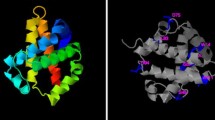Abstract.
Recent work in the α thalassaemia field has started to provide some indication of the mechanisms involved in the very high frequency of the different forms of α thalassaemia among the populations of tropical countries, and, at the same time, is starting to define at least some of the mechanisms for its remarkable phenotypic heterogeneity. These diseases continue to provide extremely valuable models for the better understanding of the regulation of the α globin genes, and for human molecular pathology in general. The much less common disorders, ATR-16 and ATR-X are also providing valuable information about the spectrum of molecular lesions associated with different forms of mental retardation and about the molecular mechanisms involved in their varying phenotypes.
Similar content being viewed by others
Author information
Authors and Affiliations
Corresponding author
Additional information
Received 29 August 2008; received after revision 07 October 2008; accepted 14 October 2008
Rights and permissions
About this article
Cite this article
Higgs, D.R., Weatherall, D.J. The Alpha Thalassaemias. Cell. Mol. Life Sci. 66, 1154–1162 (2009). https://doi.org/10.1007/s00018-008-8529-9
Published:
Issue Date:
DOI: https://doi.org/10.1007/s00018-008-8529-9




